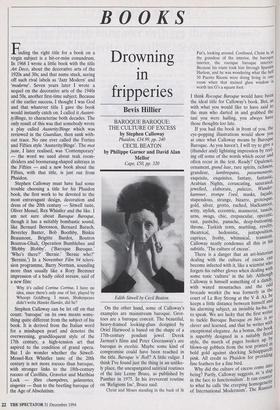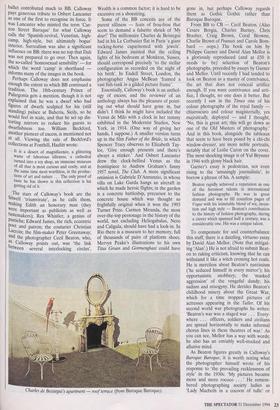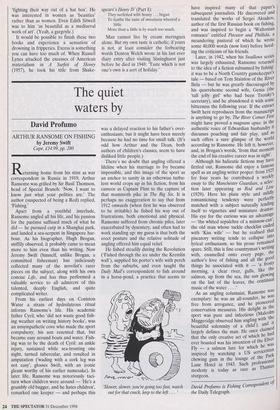BOOKS
Drowning in fripperies
Bevis Hillier
Fording the right title for a book on a virgin subject is a hit-or-miss conundrum. In 1968 I wrote a little book with the title Art Deco, about the decorative arts of the 1920s and 30s; and that name stuck, seeing off such rival labels as 'Jazz Modern' and `moderne'. Seven years later I wrote a sequel on the decorative arts of the 1940s and 50s, another first-time subject. Because of the earlier success, I thought I was God and that whatever title I gave the book would instantly catch on. I called it Austeri- ty/Binge, to characterise both decades. The only result of this was that somebody wrote a play called AusteritylBinge which was reviewed in the Guardian, then sank with- out trace. No one ever called the Forties and Fifties style 'Austerity/Binge'. The mot juste, I later realised, was 'Contemporary' — the word we used about teak room- dividers and boomerang-shaped ashtrays in the Fifties — and a new book about the Fifties, with that title, is just out from Phaidon.
Stephen Calloway must have had some trouble choosing a title for his Phaidon book, the first work to be devoted to the most extravagant design, decoration and dress of the 20th century — Sitwell taste, Oliver Messel, Rex Whistler and the like. I am not sure about Baroque Baroque, though it has a suitably bombastic sound, like Bernard Berenson, Bernard Baruch, Beverley Baxter, Bob Boothby, Binkie Beaumont, Brigitte Bardot, Boutros Boutros-Ghali, Operation Bumblebee and `Blobby Blobby'. (Baroque Baroque.' `Who's there?' Bernie."Bernie who?' `Bemini.) In a November Film 94 televi- sion programme, Barry Norman, sounding more than usually like a Rory Bremner impression of a badly oiled seesaw, said of a new film: Why it's called Corrina Covina, I have no idea, since there's only one of her, played by Whoopi Goldberg. I mean, Shakespeare didn't write Hamlet Hamlet, did he?
Stephen Calloway can be let off on that count: 'baroque' on its own means some- thing quite different from the subject of his book. It is derived from the Italian word for a misshapen pearl and denotes the overweening, grandiloquent style of the 17th century, a high-tension art that aspired to the condition of grand opera. But I do wonder whether the Sitwell- Messel-Rex Whistler taste of the 20th century is not more rococo than baroque, with stronger links to the 18th-century rococo of Cuvillies, Gravelot and Matthias Lock — fetes champetres, galanteries, singeries — than to the beetling baroque of the Age of Absolutism. Edith Sitwell by Cecil Beaton On the other hand, some of Calloway's examples are mainstream baroque. Grot- toes are a baroque conceit. The beautiful, heavy-framed looking-glass designed by Oriel Harwood is based on the shape of a 17th-century pendant jewel. Derek Jarman's films and Peter Greenaway's are baroque in excelsis. Maybe some kind of compromise could have been reached in the title. Baroque 'ii' Roll? A little vulgar. I think I've found just the thing in an unlike- ly place, the unexpurgated satirical routines of the late Lenny Bruce, as published by Panther in 1975. In his irreverent routine on 'Religions Inc', Bruce said:
Christ and Moses standing in the back of St Pat's, looking around. Confused, Christ is, at the grandeur of the interior, the baroque interior, the rocoque baroque interior. Because his route took him through Spanish Harlem, and he was wondering what the hell 50 Puerto Ricans were doing living in one room when that stained glass window Is worth ten G's a square foot.
I think Rocoque Baroque would have been the ideal title for Calloway's book. But, as with what you would like to have said to the man who darted in and grabbed the taxi you were hailing, you always have those thoughts too late. If you had the book in front of you, the eye-popping illustrations would show you at once what Calloway means by Baroque Baroque. As you haven't, I will try to give a (thunder and) lightning impression by reel- ing off some of the words which occur and often recur in the text. Ready? Opulence, ornament, grand luxe, rare spirits, richness, grandeur, lambrequin, passementerie, exquisite, exquisites, fantasy, fantastic, Arabian Nights, coruscating, saturated, jewelled, elaborate, palazzo, Wunder- kammer, trompe l'oeil, masks, façade, stupendous, strange, bizarre, grotesque, gold, silver, grotto, ruched, bla.61camonr, witty, stylish, eccentric, mannerist, tassels, urns, swags, chic, crepuscular, operatic, vast, pastiche, panache, deep-buttoning, throne, Turkish tents, marbling, revelry' theatrical, hedonistic, juxtaposition, caprices, frothy, whimsical, transient. Calloway neatly condenses all this in his subtitle, 'The culture of excess'. There is a danger that an art-historian dealing with the culture of excess can become infected with it, like a scientist who forgets his rubber gloves when dealing with some toxic 'culture' in the lab. Although Calloway is himself something of a dandy, with waxed moustaches and the odd brocade westkit (he was formerly in the court of Le Roy Strong at the V & A), he keeps a little distance between himself and his alarming subject, an invisible ha-ha, so to speak. We are lucky that the first writer to tackle Baroque Baroque en bloc is so clever and learned, and that he writes with exceptional elegance. As a bonus, the booK. is superbly designed in a suitably florid style, the march of pages broken up by blown-up gobbets from the text printed bold gold against shocking Schiappareill pkine feathers All ecrrs fora fin t to bird. for providing fine Why did the culture of excess come into being? Partly, Calloway suggests, as 'a slapr in the face to functionalism'. It ran counter to what he calls 'the creeping homogeneity of International Modernism'. The Russian ballet contributed much to BB. Calloway pays generous tribute to Osbert Lancaster as one of the first to recognise its force. It was Lancaster who minted the term 'Cur- zon Street Baroque' for what Calloway calls the 'Spanish-revival, Venetian, high- camp, high-style, but ultimately bogus' interior. Surrealism was also a significant influence on BB: there was no top that Dali was not prepared to go over. Then again, the so-called 'homosexual sensibility' — for which the word 'camp' is shorthand informs many of the images in the book. Perhaps Calloway does not emphasise enough the extent to which BB continued a tradition. The 18th-century Prince of Palargonia gets a mention, though it is not explained that he was a dwarf who had figures of dwarfs sculpted for his (still standing) palace at Baheria, Sicily, so he would feel in scale, and that he set up dis- torting mirrors to reduce his guests to dwarfishness too. William Beckford, another pioneer of excess, is mentioned not at all. Viewing the sale of Beckford's collections at Fonthill, Hazlitt wrote:
It is a desert of magnificence, a glittering waste of laborious idleness, a cathedral turned into a toy shop, an immense museum of all that is most curious and costly, and at the same time most worthless, in the produc- tions of art and nature . . . The only proof of taste he has shown in this collection is his getting rid of it.
The stars of Calloway's book are the Sitwell 'triumvirate', as he calls them, making Edith an honorary man (they were important as publicists as well as tastemakers); Rex Whistler, a genius of pastiche; Edward James, the rich, eccentric Poet and patron; the couturier Christian Lacroix; the film-maker Peter Greenaway; and the photographer Cecil Beaton, who, between Calloway points out, was 'the link Detween several interlocking circles'. Wealth is a common factor; it is hard to be excessive on a shoestring.
Some of the BB conceits are of the purest silliness — feats of frou-frou that seem to demand a falsetto shriek of 'My dear!' The millionaire Charles de Beistegui had in his Le Corbusier flat in Paris `a giant rocking-horse caparisoned with jewels'. Edward James insisted that the ceiling lights of his bedroom at Monkton, Sussex, should correspond precisely `to the stellar configuration as recorded on the night of his birth'. In Endell Street, London, the photographer Angus McBean 'framed a vast fish-tank in a gilded picture frame'.
Essentially, Calloway's book is an anthol- ogy of excess; and the reviewer of an anthology always has the pleasure of point- ing out what should have gone in, but didn't. I think he might have included the Venus de Milo with a clock in her tummy exhibited in the Modernist Studios, New York, in 1914. (One way of giving her hands, I suppose.) A smaller version turns up in the film Father of the Bride, in which Spencer Tracy observes to Elizabeth Tay- lor, 'Give enough presents and there's always a stinker.' And Osbert Lancaster drew the clock-bellied Venus as the frontispiece to Andrew Graham's funny 1957 novel, The Club. A more significant omission is Gabriele D'Annunzio, in whose villa on Lake Garda hangs an aircraft in which he made heroic flights; in the garden is a concrete battleship, precursor to the concrete house which was thought so frightfully original when it won the 1993 Turner Prize. Carmen Miranda, the most over-the-top personage in the history of the world, not excluding Heliogabalus, Nero and Caligula, should have had a look-in. In Rio there is a museum to her memory, full of thousands of pairs of platform shoes. Mervyn Peake's illustrations to his own Titus Groan and Gormenghast could have Charles de Beistegui's apartment — roof terrace (from Baroque Baroque). gone in, but perhaps Calloway regards them as Gothic Gothic rather than Baroque Baroque.
From BB to CB — Cecil Beaton. (Also Cesare Borgia, Charles Burney, Chris Brasher, Craig Brown, Coral Browne, Charlie Brown of Peanuts and Carole Bom- bard — oops.) The book on him by Philippe Garner and David Alan Mellor is a gloriously reproduced (and at £50 it needs to be) selection of Beaton's photographs, preceded by essays by Garner and Mellor. Until recently I had tended to look on Beaton as a master of contrivance, the art that does not conceal artifice enough. If you want contrivance and arti- fice, I thought, no one does it better. But recently I saw in the Times one of his colour photographs of the royal family — chiaroscuro and colour magisterially, yes majestically, deployed — and I thought, `No, this is great art; this will go down as one of the Old Masters of photography.' And in this book, alongside the tableaux that seem to have been posed by a chi-chi window-dresser, are more noble portraits, notably that of Leslie Caron on the cover. The most shocking image is of Yul Brynner in 1946 with glossy black hair.
Garner's essay is pedestrian, not even rising to the 'amusingly journalistic', to borrow a phrase of his. A sample: Beaton rapidly achieved a reputation as one of the foremost talents in international fashion photography. He was in great demand and was to fill countless pages of Vogue with his inimitable blend of wit, inven- tion and high style — Beaton's contribution to the history of fashion photography, during a career which spanned half a century, was a considerable one. His was a unique talent.
To compensate for and counterbalance this stuff, there is a dazzling, virtuoso essay by David Alan Mellor. (Note that mitigat- ing 'Alan%) He is not afraid to submit Beat- on to raking criticism, knowing that he can withstand it like a witch crossing hot coals. He is merciless about Beaton's narcissism (`he seduced himself in every mirror'); his opportunistic snobbery; the 'masked aggression' of the vengeful dandy; his sadism and misogyny. He derides Beaton's childhood misery about the Great War, which for a time stopped pictures of actresses appearing in the Tatler. Of his second world war photographs he writes: 'Beaton's war was a staged war . . . Every- where . . . officers, soldiers and civilians are spread horizontally to make informal chorus lines in these theatres of war.' As you can see, Mellor has a way with words; he also has an enviably well-stocked and allusive mind.
As Beaton figures greatly in Calloway's Baroque Baroque, it is worth noting what the photographer himself wrote of his response to 'the prevailing recklessness of style' in the 1930s: 'My pictures became more and more rococo . . . ' He remem- bered photographing society ladies as `Lady Macbeth in a cocoon of tulle' or `fighting their way out of a hat box'. He was interested in women as 'beauties' rather than as women. Even Edith Sitwell was to him 'as beautiful as a mediaeval work of art'. (Yeah, a gargoyle.) It would be possible to finish these two books and experience a sensation of drowning in fripperies. Excess is something you can have too much of. When Russell Lynes attacked the excesses of American materialism in A Surfeit of Honey (1957), he took his title from Shake- speare's Henry IV (Part I):
They surfeited with honey . , . began To loathe the taste of sweetness whereof a little More than a little is by much too much.
Man cannot live by cream meringues alone. But my own taste is catholic; if yours is not, at least consider the forbearing words Denton Welch wrote in his last ever diary entry after visiting Sissinghurst just before he died in 1948: 'Taste which is not one's own is a sort of holiday.'




























































 Previous page
Previous page